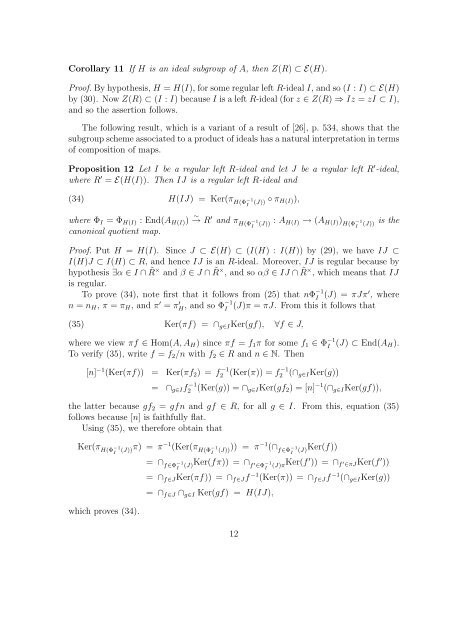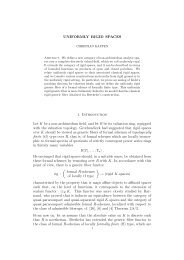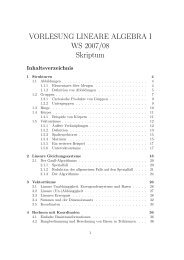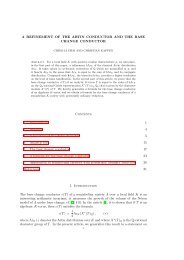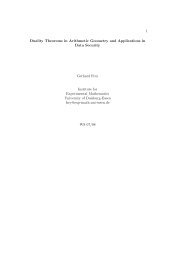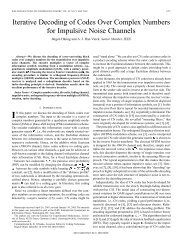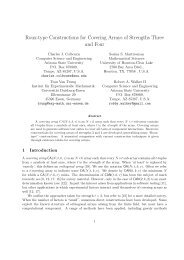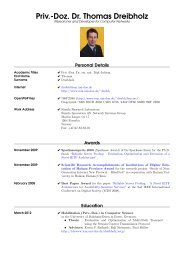Corollary 11 If H is an ideal subgroup <strong>of</strong> A, then Z(R) ⊂ E(H).Pro<strong>of</strong>. By hypothesis, H = H(I), for some regular left R-ideal I, and so (I : I) ⊂ E(H)by (30). Now Z(R) ⊂ (I : I) because I is a left R-ideal (for z ∈ Z(R) ⇒ Iz = zI ⊂ I),and so the assertion follows.The following result, which is a variant <strong>of</strong> a result <strong>of</strong> [26], p. 534, shows that thesubgroup scheme associated to a product <strong>of</strong> ideals has a natural interpretation in terms<strong>of</strong> composition <strong>of</strong> maps.Proposition 12 Let I be a regular left R-ideal and let J be a regular left R ′ -ideal,where R ′ = E(H(I)). Then IJ is a regular left R-ideal and(34)H(IJ) = Ker(π H(Φ−1I (J)) ◦ π H(I)),where Φ I = Φ H(I) : End(A H(I) ) → ∼ R ′ and π H(Φ−1I (J)) : A H(I) → (A H(I) ) H(Φ−1Icanonical quotient map.(J))is thePro<strong>of</strong>. Put H = H(I). Since J ⊂ E(H) ⊂ (I(H) : I(H)) by (29), we have IJ ⊂I(H)J ⊂ I(H) ⊂ R, and hence IJ is an R-ideal. Moreover, IJ is regular because byhypothesis ∃α ∈ I ∩ ˜R × and β ∈ J ∩ ˜R × , and so αβ ∈ IJ ∩ ˜R × , which means that IJis regular.To prove (34), note first that it follows from (25) that nΦ −1In = n H , π = π H , and π ′ = π H ′ , and so Φ−1I(35)(J) = πJπ ′ , where(J)π = πJ. From this it follows thatKer(πf) = ∩ g∈I Ker(gf), ∀f ∈ J,where we view πf ∈ Hom(A, A H ) since πf = f 1 π for some f 1 ∈ Φ −1I(J) ⊂ End(A H ).To verify (35), write f = f 2 /n with f 2 ∈ R and n ∈ N. Then[n] −1 (Ker(πf)) = Ker(πf 2 ) = f −12 (Ker(π)) = f −12 (∩ g∈I Ker(g))= ∩ g∈I f −12 (Ker(g)) = ∩ g∈I Ker(gf 2 ) = [n] −1 (∩ g∈I Ker(gf)),the latter because gf 2 = gfn and gf ∈ R, for all g ∈ I. From this, equation (35)follows because [n] is faithfully flat.Using (35), we therefore obtain thatKer(π H(Φ−1Iwhich proves (34).(J)) π) = π−1 (Ker(π H(Φ−1(J)) )) = π−1 (∩ f∈Φ−1(J) Ker(f))I= ∩ f∈Φ−1I (J) Ker(fπ)) = ∩ f ′ ∈Φ −1I (J)π Ker(f ′ )) = ∩ f ′ ∈πJKer(f ′ ))= ∩ f∈J Ker(πf)) = ∩ f∈J f −1 (Ker(π)) = ∩ f∈J f −1 (∩ g∈I Ker(g))= ∩ f∈J ∩ g∈I Ker(gf) = H(IJ),12I
2.4 The quadratic caseWe now specialize the discussion to the case that ˜R is a quadratic field F ⊃ Q. SinceR is finitely generated (as a Z-module), it follows that R is an order <strong>of</strong> F = ˜R, i.e. Ris a subring <strong>of</strong> F which is lattice. We first recall some basic facts about such ordersand lattices (cf. [3], §II.7 or [6], ch. 7).Every order R <strong>of</strong> F is contained in the maximal order O F , the ring <strong>of</strong> integers <strong>of</strong> F ,and is uniquely determined by its conductor f R := [O F : R]. Indeed, if ∆(R) := f 2 R ∆ F ,where ∆ F = ∆(O F ) is the discriminant <strong>of</strong> F (or, more correctly, <strong>of</strong> O F ), then we have(36)R = R ∆ := Z + Zω ∆ , where ω ∆ = 1 2 (∆ + √ ∆).Thus, R is also uniquely determined by its discriminant ∆(R). Conversely, for eachinteger f there is unique order <strong>of</strong> conductor f. Moreover, if R 1 , R 2 are orders in Fthen we have(37)R 1 ⊂ R 2 ⇔ f R2 |f R1 and hence f R1 R 2= (f R1 , f R2 ), f R1 ∩R 2= lcm(f R1 , f R2 ).Let Lat F denote the set <strong>of</strong> lattices <strong>of</strong> F , i.e. the set <strong>of</strong> finitely generated subgroupsL <strong>of</strong> F such that LF = F . If L ∈ Lat F , then R(L) := (L : L) is an order <strong>of</strong> F , andfor a given order R, the setLat(R) = {L ∈ Lat F : R(L) = R}is the set <strong>of</strong> invertible R-submodules <strong>of</strong> F , and hence forms an abelian group underthe multiplication <strong>of</strong> lattices. Here the identity is R and the inverse <strong>of</strong> L is(38)L −1 = (R(L) : L) = σ(L)N(L) −1 ,where σ ∈ Gal(F/Q) is the unique nontrivial automorphism <strong>of</strong> F and N(L) ∈ Q × isthe norm <strong>of</strong> L. Moreover, the groupPic(R) = Lat(R)/{fR : f ∈ F × }is a finite abelian group whose order is denoted by h(R) = h(∆(R)).For later reference we recall the following useful formulae (cf. [6], p. 151):(39)R(L 1 L 2 ) = R(L 1 )R(L 2 ) and N(L 1 L 2 ) = N(L 1 )N(L 2 ).In addition, we have following formulae (40) and (41) will be used several timesbelow. Since there does not seem to be a suitable reference, we provide a pro<strong>of</strong> <strong>of</strong>these identities. Note that (41) is stated without pro<strong>of</strong> on p. 71 <strong>of</strong> [12].13
- Page 1: Products of CM elliptic curves1 Int
- Page 7 and 8: Indeed, if If is a kernel ideal, th
- Page 9 and 10: Indeed, by (18) we have I 1 f = I 2
- Page 11: Proof. To prove (29), let h ∈ Hom
- Page 15 and 16: ecause here f 2 |f 1 , so f = f 2 a
- Page 17 and 18: For this, put f = [R ′ : R], I =
- Page 19 and 20: From (54) we can conclude that(55)d
- Page 21 and 22: If H is any finite subgroup scheme
- Page 23 and 24: E. As we shall see, it is very illu
- Page 25 and 26: From this we see on the one hand th
- Page 27 and 28: Proposition 30 Let L ∈ Lat F , wh
- Page 29 and 30: (b) Deuring[10], p. 263. Note that
- Page 31 and 32: integral quadratic formq L,α,β (x
- Page 33 and 34: Corollary 39 Let E 1 /K and E 2 /K
- Page 35 and 36: Proof. Write π i = π Hi : A → A
- Page 37 and 38: (a) The order R is cyclic if and on
- Page 39 and 40: for k = 1, . . . , n − 2. Moreove
- Page 41 and 42: 4.3 Products of CM elliptic curvesW
- Page 43 and 44: Corollary 56 Let E/K be a CM ellipt
- Page 45 and 46: Case 2. char(K) = 0.As was mentione
- Page 47 and 48: Let h A/K (X) ∈ Z[X] (respectivel
- Page 49 and 50: Proof. To prove this, we shall use
- Page 51 and 52: where xy denotes the quadratic form
- Page 53 and 54: denote the set of isomorphism class


